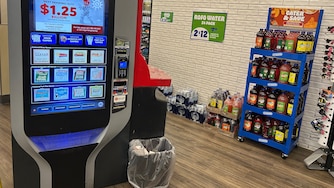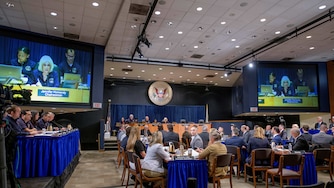Mélisande Short-Colomb wants educational institutions and America to confront their history with the slave economy.
For the past 18 months, she has been part of a 12-person task force looking into how Loyola University Maryland benefited from the sale of enslaved Black people in 1838.
“They are very brave souls who are stepping into accountability for the students, alumni, community, and America,” said Short-Colomb, who can trace her family back 12 generations to 1680.
On Wednesday, Terrence M. Sawyer, the president of Loyola University Maryland, will officially acknowledge the university’s past role in benefiting from the slave economy — with the extent detailed in a nearly 40-page report. In April, “Untold Truths: Exposing Slavery and Its Legacies at Loyola,” a more detailed 334-page account, will be published.
Jesuit schools like Loyola and Georgetown universities benefited from the sale of the enslaved people in 1838, according to Short-Colomb.
“That money went to [the Maryland Province of the Society of Jesus]. Every school that was born and every Jesuit initiative that was created, was created from that loan or sale and from those families from that foundation, from the enslavement and human trafficking scheme.”
Sawyer said he joined then-interim president Amanda M. Thomas in December 2021 in forming the task force to initiate and guide a university-wide examination of Loyola’s connections to slavery and its continuing legacies — adding that it is “important to investigate and identify Loyola’s historical relationship to slavery so we could address those issues and move forward together as a community.”
Loyola, a liberal arts university which has a main campus in North Baltimore and a graduate center in Timonium, has nearly 4,000 undergraduate students and more than 1,100 graduate students.
”Although we cannot change the past, we must understand the full impact of past events and actions to be able to move forward. As a Jesuit, Catholic university, we must always seek truth, honestly engage with our past — as difficult as that can be — and respond with continued action as we work to create a more hope-filled future,” he added.
Before the Civil War, few institutions were not connected to the slave economy in some form, said David Carey Jr., the Doehler Chair in History at Loyola. Carey was part of the task force formed in early 2022 to delve into Loyola’s connection to the slave economy.
“I suspect this is not going to shock many Black residents in Baltimore that Loyola has this legacy,” Carey said. “Hopefully this will show that Loyola is trying to be transparent and treat this with integrity, and we welcome feedback from Black residents in Baltimore.”
Short-Colomb, who works on Georgetown University’s board of advisors for the Georgetown Memory Project and is a founding council member of the GU272 Descendants Association, which commemorates the people sold in 1838 and their descendants, credits Sawyer for his willingness to embark on this endeavor.
“Since Georgetown there has been no Jesuit school that has stood up and said, ‘Yeah, us too, we are beneficiaries of this too,’ ” Short-Colomb said. “Nobody else did it. The president before him said that slavery had nothing to do with him. If you were a Jesuit school created in the 18th century and 19th century, you bet your bottom line that it [slave economy] had something to do with you.”
The report will also include up to a dozen explicit recommendations, ranging from possible reparations to repairs and to other forms of reconciliation, according to Carey.
“There are a number of ways the university might approach it,” he said.
“We should have done this decades ago,” Carey said, adding that a perfect time to examine the history could have coincided with Rachel Swarns’ 2023 book “The 272: The Families Who Were Enslaved and Sold to Build the American Catholic Church.”
“It’s happened so many other places.”
Loyola worked closely with Georgetown University because the archives of The Maryland Province of the Society of Jesus are there.
According to those archives, the Jesuits in 1838 sold more than 272 enslaved people — most of the men, women, and children owned by the province — to two Louisiana planters and slave traders.
“The profits from the sale enabled the Province to solidify its economic standing, lay the foundation for its expansion into the Northeast, and fund Georgetown College,” the archives state.
Slavery was a contentious topic among Maryland Jesuits.
Before 1838, the subject of slaveholding had generated debate for some time among the Maryland Jesuits.
“As early as 1813, the Corporation of Roman Catholic Clergymen and Provincial Consultors had considered whether or not to sell the enslaved people who labored on the six Jesuit plantations in Maryland, and they decided to authorize the sale of smaller groups of enslaved people,” according to the archives.
Arguments ranged from the economic benefits of transitioning to tenant farming to the problems posed by enslaved people’s resistance, as well as other “perceived transgressions” on the part of enslaved people, the archives state.
The undertaking began in January 2022 with the formation of the task force — a mix of students, faculty and descendants of the 1838 sale of enslaved people. That summer, student research began. Loyola joined Universities Studying Slavery consortium, a national group of universities that investigate their connections to slavery.

“Almost all that we found was through undergraduate student researchers,” Carey said. “They are thinking about it, interpreting, analyzing it in sophisticated ways. They have been great.”
Alexis Faison, 22, an Interdisciplinary political science and journalism major, has played a major role on the task force since 2022.
Faison, who identifies as African American, Caucasian, and Native American, said she was most surprised by how much history the university was “sitting on.” Ultimately, it took the work of The New York Times and other individuals looking into that research that “kick started” the process of examining the history.
“I think we have to acknowledge that this announcement is not an easy one to hear — whether you are directly or indirectly impacted by it,” Faison said. “Whether you are student, alumni or partner with the university, this will be important information to hear. I want to strengthen and acknowledge how we respond to this history.”
Faison said she expects fellow students to be somewhat surprised by the depth of the research.
“This is not surface-level. It’s fully embedded in the literal architecture and how the campus came to be,” she said. “It will have them question their role in all of this. It will challenge them to be fully aware and if they are able to step outside of their comfort zone. There will be a bit of surprise and shock, but overall a willingness to further examine the material in-depth and their role in how they occupy the campus.”
Loyola — founded in 1852 and the first college in the United States to bear the name of St. Ignatius of Loyola, the founder of the Society of Jesus — is not the first institution of higher learning to acknowledge its involvement in slavery.
In 2017, Georgetown and the Society of Jesus’ Maryland Province apologized for their roles in the 1838 sale of more than 270 enslaved Black people for the university’s benefit.
In 2019, The Reconciliation Fund, which was inspired by a student referendum, was launched. The fund, which receives $27.20 from each student, awards $400,000 annually to community-based projects that have “direct impact on Descendant communities whose ancestors were once enslaved on the Maryland Jesuit plantations,” according to Georgetown University.
And in 2020, the Johns Hopkins University acknowledged that its founder and benefactor, Johns Hopkins, owned slaves until the mid-1800s. This contradicted “the oft-repeated narrative that … his father, ‘following the directives of his Quaker faith, freed the family’s slaves,’” Hopkins said in a 2020 news release. Records found by Johns Hopkins professor Martha Jones showed that Hopkins’ grandfather freed eight enslaved people in 1778, but kept dozens of others in bondage, the release noted.
But Loyola is the first Jesuit school outside of Georgetown to acknowledge the link, according to Short-Colomb.
“Loyola has taken a huge step in acknowledging that they are the recipients of funding from that 1838 sale,” she said.
Carey said Wednesday’s announcement is just the beginning.
“We don’t see this as a final report. This is a part of the process. This will open up the conversation,” Carey said.
This story has been updated to reflect that Johns Hopkins' grandfather freed eight enslaved people in 1778, though he kept dozens of others in bondage.





Comments
Welcome to The Banner's subscriber-only commenting community. Please review our community guidelines.